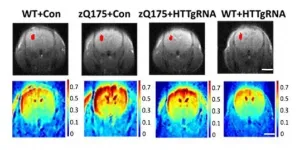Like a molten pancake
New model for shield volcano eruption
2021-07-07
(Press-News.org) There are some large shield volcanoes in the world's oceans where the lava is usually not ejected from the crater in violent explosions, but flows slowly out of the ground from long fissures. In the recent eruption of the Sierra Negra volcano in the Galapagos Islands, which lie just under a thousand kilometres off South America in the Pacific Ocean, one of these fissures was fed through a curved pathway in June 2018. This 15 kilometre-long pathway, including the kink, was created by the interaction of three different forces in the subsurface, Timothy Davis and Eleonora Rivalta from the GFZ German Research Centre for Geosciences in Potsdam, together with Marco Bagnardi and Paul Lundgren from NASA's Jet Propulsion Laboratory in Pasadena, now explain based on computer models in the journal Geophysical Research Letters.
Even before the eruption, the geoscientists in California had seen in radar satellite data that the surface of the flank of the 1140-metre-high Sierra Negra volcano had bulged to a height of about two metres: this bulge, about five kilometres wide, stretched from the crater rim about ten kilometres in a west-northwest direction and turned at a right angle to the north-northeast near the coast. Timothy Davis and his team then found out what this structure and its perplexing bend were all about with the help of computer models.
Driving Force 1: Hotspot beneath the Galapagos Islands
As with many other volcanoes in the middle of the world's oceans, a "hotspot" is hidden beneath the Galapagos Islands. For at least 20 million years, hot rock has been rising slowly from deep within the Earth's interior, like a solid, but difficult-to-form plasticine. Like a blowtorch, this hotspot, up to 200 kilometres wide, melts its way through the solid crust of the Earth. This hot magma is a little lighter than the solid rock around it, so it keeps rising until it collects in a large cavity about two kilometres below the crater of the Sierra Negra volcano. "With a diameter of around six kilometres and a thickness of no more than one kilometre, this magma chamber resembles an oversized pancake of molten rock," Timothy Davis describes this structure.
Driving Force 2: the Weight of the Volcano Rock
In the almost 13 years since the last eruption in October 2005, more and more magma has flowed into the chamber from below. There, the pressure rose and lifted the crater floor up to 5.20 metres. However, the enormous force of the gathering magma masses sought another way out. Deep underground, the viscous rock slowly crawled in a west-northwest direction. Another force plays an important role here: the enormous weight of the volcano's rock masses presses from above on the magma flow that is just forming. As the shield volcano becomes flatter and flatter towards the outside, the pressure there also decreases. As the molten rock is pressed in the direction with lower pressure, it slowly swells outwards in a magma flow that is four kilometres wide but only about two metres high.
Driving Force 3: Buoyancy
Near the coastline, the flattening shield volcano presses ever more weakly on the now almost ten-kilometre-long magma corridor deep below the surface. There, a third force gains the upper hand. The magma is much lighter than the rock around the passage and was previously only prevented from swelling by the overlying weight of the shield volcano. Near the coastline, however, this buoyancy becomes stronger than the pressure of the rock from above. On top of that, the magma slope there tilts about ten degrees into the depths. Together, these forces change the direction in which the viscous rock is pressed and the magma slope bends towards the north-northeast.
The rock cracks, the volcano erupts
Still, the magma swelling under the crater continues to increase the pressure until the upward-pressing molten mass begins to crack the rock around the magma passage. At no more than walking speed, this magma-filled crack (dyke) is travelling deep underground towards the coastline. "The magma rising from the crack reaches the surface after a few days and continues to flow there as lava, which solidifies after some time," Timothy Davis explains the subsequent course of the volcanic eruption.
Important prerequisite for prediction and hazard minimization
For the first time, the geophysicist was able to simulate such a tortuous magma propagation pathway feeding an eruption and determine the forces that control this. Timothy Davis and Eleonora Rivalta, together with their colleagues in California, have thus laid important foundations for research into such fissure eruptions. And they have taken a decisive step towards predicting such eruptions and thus reducing the dangers they pose.
INFORMATION:
ELSE PRESS RELEASES FROM THIS DATE:
2021-07-07
Driving through a tunnel is a challenging and risky task. Drivers need to lower their speed and adapt to poor light, while the enclosed space may make them anxious. Preventing accidents is a public health challenge that uses insights from engineering, psychology, physiology, and neuroscience. Here, in a virtual reality (VR) study in Frontiers in Psychology, scientists from China, Canada, and the USA show that playback of slow music inside tunnels can reduce tension and fatigue in drivers, making them less prone to speeding and overtaking. These results imply that well-chosen background music can help improve road safety.
"When drivers go through a tunnel, they need to process a large amount ...
2021-07-07
How do predators know to avoid brightly-coloured toxic prey? A collaboration of researchers has put social information theory to the test in a reliable real-world system to find the answer - by copying what others do, or do not, eat.
An international team of researchers from Finland, New Zealand, Colombia and the U.K. have provided the first evidence that wild birds can learn to avoid distasteful prey by observing what others eat.
"We've known for a long time that predators, like birds, associate brightly coloured warning signals with the danger of eating certain prey types. However, ...
2021-07-07
Imagine a dust particle in a storm cloud, and you can get an idea of a neutron's insignificance compared to the magnitude of the molecule it inhabits.
But just as a dust mote might affect a cloud's track, a neutron can influence the energy of its molecule despite being less than one-millionth its size. And now physicists at MIT and elsewhere have successfully measured a neutron's tiny effect in a radioactive molecule.
The team has developed a new technique to produce and study short-lived radioactive molecules with neutron numbers they can precisely control. They hand-picked several isotopes of the same molecule, each with one more neutron than the next. When they measured each molecule's energy, they were able to detect small, nearly imperceptible changes of the nuclear ...
2021-07-07
BOSTON - The numbers of cancer screening tests rebounded sharply in the last quarter of 2020, following a dramatic decline in the first months of the COVID-19 pandemic, at one large hospital system in the Northeastern United States. These findings were released in a study published in Cancer Cell. The research also found an increase in racial and socioeconomic disparities among users of some screening tests during the pandemic.
Study co-senior author Toni K. Choueiri, MD, director of the Lank Center for Genitourinary Oncology at Dana-Farber Cancer Institute, said following a dramatic decline during the first pandemic peak, there was a "substantial increase in screening procedures during the more recent periods ...
2021-07-07
LAWRENCE -- A new paper appearing in Biology Letters describes the oldest-known fragmentary bat fossils from Asia, pushing back the evolutionary record for bats on that continent to the dawn of the Eocene and boosting the possibility that the bat family's "mysterious" origins someday might be traced to Asia.
A team based at the University of Kansas and China performed the fieldwork in the Junggar Basin -- a very remote sedimentary basin in northwest China -- to discover two fossil teeth belonging to two separate specimens of the bat, dubbed Altaynycteris aurora.
The new fossil specimens help scientists better understand ...
2021-07-07
Dutch-French research shows that Optical Genome Mapping (OGM) detects abnormalities in chromosomes and DNA very quickly, effectively and accurately. Sometimes even better than all existing techniques together, as they describe in two proof-of-concept studies published in the American Journal of Human Genetics. This new technique could radically change the existing workflow within cytogenetic laboratories.
Human hereditary material is stored in 46 chromosomes (23 pairs). Although those chromosomes are quite stable, changes in number or structure can still occur. A well-known example is Down syndrome, which is caused by an extra ...
2021-07-07
A decade's worth of data shows that neonatologists are shifting the type of respiratory support they utilize for preterm infants, a move that could lead to improved health outcomes.
Using two large national datasets that included more than 1 million preterm infants, researchers in a new Vanderbilt-led study found that from 2008 to 2018 there was a greater than 10% decrease in the use of mechanical ventilation for this patient population. Concurrently, there was a similar increase in the use of non-invasive respiratory support, such as continuous positive airway pressure (CPAP), for these infants.
The ...
2021-07-07
(Boston)--The discovery of novel groups or categories within diseases, organisms and biological processes and their organization into hierarchical relationships are important and recurrent pursuits in biology and medicine, which may help elucidate group-specific vulnerabilities and ultimately novel therapeutic interventions.
Now a new study introduces a novel computational methodology and an associated software tool called K2Taxonomer, which support the automated discovery and annotation of molecular classifications at multiple levels of resolution from high-throughput bulk and single cell 'omics' data. The study includes a case ...
2021-07-07
SILVER SPRING, Md.--Vaccines such as Pfizer, Moderna, Johnson & Johnson and AstraZeneca are designed to prevent severe Coronavirus-19 Disease (COVID-19) due to acute respiratory syndrome coronavirus 2 (SARS-CoV-2) and are highly efficacious. The efficacy is not different in people with and without obesity except for AstraZeneca which is not known, according to a new position statement from The Obesity Society (TOS), the leading scientific membership organization advancing the science-based understanding of the causes, consequences, prevention and treatment of obesity.
Trials have demonstrated high efficacy in individuals ...
2021-07-07
In a new study on mice, Johns Hopkins Medicine researchers report that using MRI scans to measure blood volume in the brain can serve as a noninvasive way to potentially track the progress of gene editing therapies for early-stage Huntington's disease, a neurodegenerative disorder that attacks brain cells. The researchers say that by identifying and treating the mutation known to cause Huntington's disease with this type of gene therapy, before a patient starts showing symptoms, it may slow progression of the disease.
The findings of the study were published May 27 in the journal Brain.
"What's exciting about this study is the opportunity to identify a reliable biomarker that can ...
LAST 30 PRESS RELEASES:
[Press-News.org] Like a molten pancake
New model for shield volcano eruption


